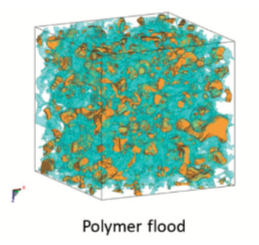
Published 2018-12-18
Keywords
- Polymer flood, water flood, Enhanced Oil Recovery (EOR), wettability, microscopic displacement efficiency, digital rock physics (DRP)
How to Cite
Copyright (c) 2018 Revista Fuentes

This work is licensed under a Creative Commons Attribution 4.0 International License.
Abstract
Polymer flooding is an enhanced oil recovery (EOR) technique that aims to enhance the stability of the flood front in order to increase sweep efficiency and thereby increase hydrocarbon recovery. Polymer flooding studies often focus on large-scale sweep efficiency and neglect the impact of the pore-scale displacement efficiency of the multi-phase flow. This work explores the pore-scale behavior of water vs polymer flooding, and examines the impact of rock surface wettability on the microscopic displacement efficiency using digital rock physics. In this study, a micro-CT image of a sandstone rock sample was numerically simulated for both water and polymer flooding under oil-wet and water-wet conditions. All simulations were performed at a capillary number of 1E-5, corresponding to a capillary dominated flow regime. Results of the four two-phase flow imbibition simulations are analyzed with respect to displacement character, water phase break-through, viscous/capillary fingering, and trapped oil. In the water-wet scenario, differences between water flood and polymer flood are small, with the flood front giving a piston-like displacement and breakthrough occurring at about 0.4 pore volume (PV) for both types of injected fluid. On the other hand, for the oil-wet scenario, water flood and polymer flood show significant differences. In the water flood, fingering occurs and much of the oil is bypassed early on, whereas the polymer flood displaces more oil and thereby provides better microscopic sweep efficiency throughout the flood and especially around breakthrough. Overall the results for this rock sample indicate that water flood and polymer flood provide similar recovery for a water-wet condition, while the reduced mobility ratio of polymer flood gives significantly improved recovery for an oil-wet condition by avoiding the onset of microscopic (pore-scale) fingering that occurs in the water flood. This study suggests that depending on the rock-fluid conditions, the use of polymer can impact microscopic sweep efficiency, in addition to the well-known effect on macroscopic sweep behavior.
Downloads
References
Buckley, J. S., Liu, Y., & Monsterleet, S. (1998). Mechanisms of wetting alteration by crude oils. SPE journal, 3(01), 54-61.
Chen, H., Teixeira, C., & Molvig, K. (1998). Realization of fluid boundary conditions via discrete Boltzmann dynamics. International Journal of Modern Physics C, 9(08), 1281-1292.
Chen, H., Zhang, R., & Gopalakrishnan, P. (2017). U.S. Patent Application No. 15/402,732.
Crouse, B., Freed, D. M., Koliha, N., Balasubramanian, G., Satti, R., Bale, D., & Zuklic, S. (2016). A Lattice-Boltzmann Based Method Applied to Digital Rock Characterization of Perforation Tunnel Damage. In Paper SCA2016-058 presented at the International Symposium of the Society of Core Analysts held in Snow Mass, Colorado, USA.
Du, Y., & Guan, L. (2004). Field-scale polymer flooding: lessons learnt and experiences gained during past 40 years. In SPE International Petroleum Conference in Mexico. Society of Petroleum Engineers.
Jerauld, G. R., Fredrich, J., Lane, N., Sheng, Q., Crouse, B., Freed, D. M., ... & Xu, R. (2017). Validation of a Workflow for Digitally Measuring Relative Permeability. In SPE Abu Dhabi International Petroleum Exhibition & Conference. Society of Petroleum Engineers.
Meneses, A. F. O., Moreno, L. F. C., & Plata, J. A. R. (2017). Metodología experimental para la estimación de permeabilidades relativas en dos y tres fases por medio de ajuste histórico. Revista Fuentes, 15(1), 75-85.
Muggeridge, A., Cockin, A., Webb, K., Frampton, H., Collins, I., Moulds, T., & Salino, P. (2014). Recovery rates, enhanced oil recovery and technological limits. Phil. Trans. R. Soc. A, 372, 20120320.
Otomo, H., Fan, H., Hazlett, R., Li, Y., Staroselsky, I., Zhang, R., & Chen, H. (2015). Simulation of residual oil displacement in a sinusoidal channel with the lattice Boltzmann method. Comptes Rendus Mécanique, 343(10-11), 559-570.
Otomo, H., Fan, H., Li, Y., Dressler, M., Staroselsky, I., Zhang, R., & Chen, H. (2016). Studies of accurate multi-component lattice Boltzmann models on benchmark cases required for engineering applications. Journal of Computational Science, 17, 334-339.
Otomo, H., Crouse, B., Dressler, M., Freed, D. M., Staroselsky, I., Zhang, R., & Chen, H. (2018). Multi-component lattice Boltzmann models for accurate simulation of flows with wide viscosity variation. Computers & Fluids.
Pinto, M. S., Herrera, D. M., & Angarita, J. C. G. (2018). Production optimization for a conceptual model through combined use of polymer flooding and intelligent well technology under uncertainties. Revista Fuentes, 16(1), 37-45.
Sandiford, B. B. (1964). Laboratory and field studies of water floods using polymer solutions to increase oil recoveries. Journal of Petroleum Technology, 16(08), 917-922.
Shan, X., & Chen, H. (1993). Lattice Boltzmann model for simulating flows with multiple phases and components. Physical Review E, 47(3), 1815.
Shan, X., Yuan, X. F., & Chen, H. (2006). Kinetic theory representation of hydrodynamics: a way beyond the Navier–Stokes equation. Journal of Fluid Mechanics, 550, 413-441.
Velandia, J. L. P. (2013). Simulación numérica del flujo bifásico agua-petróleo en un medio poroso. Fuentes: El reventón energético, 11(2), 10.
Wassmuth, F. R., Green, K., Hodgins, L., & Turta, A. T. (2007, January). Polymer flood technology for heavy oil recovery. In Canadian international petroleum conference. Petroleum Society of Canada.
Xu, R., Crouse, B., Freed, D. M., Fager A., Jerauld G. R., Lane, N., Sheng Q. (2018). Continuous vs Discontinuous Capillary Desaturation and Implications for IOR/EOR. In Paper SCA2018-066 presented at at the International Symposium of the Society of Core Analysts held in Trondheim, Norway.
Yuming, W., Yanming, P., Zhenbo, S., Peihui, H., Rong, L., Ruibo, C., & Xianhua, H. (2013). The polymer flooding technique applied at high water cut stage in daqing oilfield. In North Africa Technical Conference and Exhibition. Society of Petroleum Engineers.
Zhang, R., Shan, X., & Chen, H. (2006). Efficient kinetic method for fluid simulation beyond the Navier-Stokes equation. Physical Review E, 74(4), 046703.